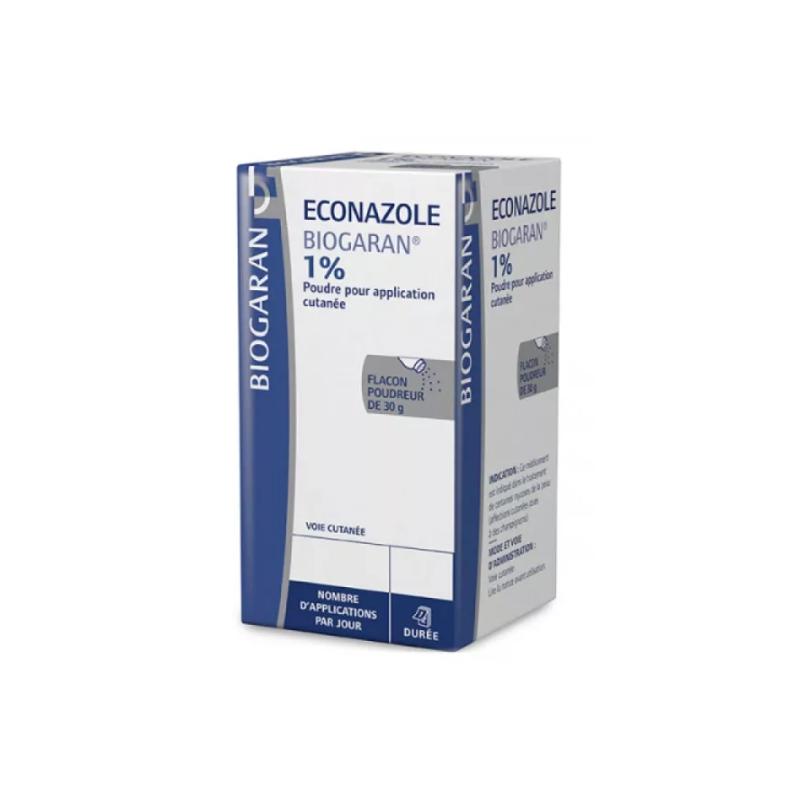1. NAME OF THE MEDICINAL PRODUCT
ECONAZOLE Biogaran, 1%, powder for cutaneous application
2. QUALITATIVE AND QUANTITATIVE COMPOSITION
Econazole nitrate ..................................................................... 1.000 g Quantity corresponding to econazole base ............................. 0.860 g For 100 g of powder for cutaneous application. For full list of excipients, see section 6.1.
3. PHARMACEUTICAL FORM
Powder for cutaneous application.
4. CLINICAL DATA
4.1 Therapeutic indications 1- Candidiasis: Cutaneous candidiasis encountered in human clinical practice is usually due to Candida albicans. However, the presence of candida on the skin does not in itself constitute an indication; - Treatment of: o intertrigos, particularly genitocrural, anal and perianal, o perlachia, o vulvitis, balanitis. In certain cases, we recommend simultaneous treatment of the digestive tract. - Adjunctive treatment of onyxis and perionyxis 2- Dermatophytoses: - Treatment: o dermatophytoses of the glabrous skin, o genital and crural intertrigos, o intertrigos of the toes (athlete's foot). o Sycosis and kerions: associated systemic antifungal treatment should be discussed. - Adjunctive treatment: o ringworm, o Trichophyton rubrum folliculitis. Associated systemic antifungal treatment is required. 3- Pityriasis versicolor 4- Erythrasma 4.2. Dosage and administration Dosage: Regular twice-daily application until complete disappearance of lesions. Method of administration: Powder the lesions to be treated by sweeping over the entire affected area twice a day, after cleansing and drying the skin. Treatment lasts from 2 to 4 weeks, depending on the mycosis, and may be longer for certain localizations.4.4 Special warnings and precautions for use Candidiasis: do not use soaps with acidic pH (pH favors Candida multiplication). 4.5. Interactions with other drugs and other forms of interaction Not applicable. 4.6. Pregnancy and lactation Not applicable. 4.7. Effects on ability to drive and use machines Not applicable. 4.8. Adverse reactions - Due to the low resorption rate of econazole (0.5% to 2%) on healthy skin, the risk of systemic effects can be practically ruled out. However, on injured skin, over a large surface area, and in infants (due to the weight-to-weight ratio and the occlusive effect of diapers), care must be taken to avoid this possibility. - Locally, the rare manifestations of intolerance are burning sensations, or sometimes pruritus and redness of the skin; these manifestations rarely lead to discontinuation of treatment (around 1.7% of cases). 4.9. Overdosage Not applicable.
5. PHARMACOLOGICAL PROPERTIES
5.1. Pharmacodynamic properties TOPICAL ANTIFUNGAL (D. Dermatological drugs) Antifungal activity has been demonstrated in vitro and is exerted on agents responsible for mucocutaneous mycoses: - Dermatophytes (Trichophyton, Epidermophyton, Microsporum), - Candida and other yeasts, - Malassezia furfur (agent of Pityriasis Capitis, Pityriasis Versicolor), - Molds and other fungi. Antibacterial activity has been demonstrated in vitro against Gram+ bacteria. Its mechanism of action, which differs from that of antibiotics, is at several levels: membrane (increased permeability), cytoplasm (inhibition of oxidative processes in mitochondria), nuclear (inhibition of N.R.A. synthesis). - Activity on Corynebacterium minutissimum (erythrasma). - Actinomycetes. 5.2. Pharmacokinetic properties In vivo experiments in healthy volunteers (with or without occlusive dressing) have shown that econazole nitrate penetrates the deepest dermal cell layers. In the upper layers of the dermis and in the epidermis, econazole nitrate reaches fungicidal concentrations. Econazole nitrate accumulates in large quantities in the stratum corneum, where it remains for 5 to 16 hours. The stratum corneum thus acts as a reservoir. The rate of systemic resorption is between 0.5% and 2% of the applied dose. Transcutaneous absorption may be increased on injured skin. 5.3. Preclinical safety data Not applicable.
6. PHARMACEUTICAL DATA
6.1. List of excipients Talc, colloidal anhydrous silica (AEROSIL 300), light zinc oxide. 6.2. Incompatibilities Not applicable. 6.3. Shelf life 3 years. 6.4. Store at a temperature not exceeding 25°C, protected from moisture. 6.5. Nature and contents of packaging 30 g powder in 66 ml powder flask (polyethylene), Box of 1. 6.6. Special precautions for disposal and handling No special requirements.




